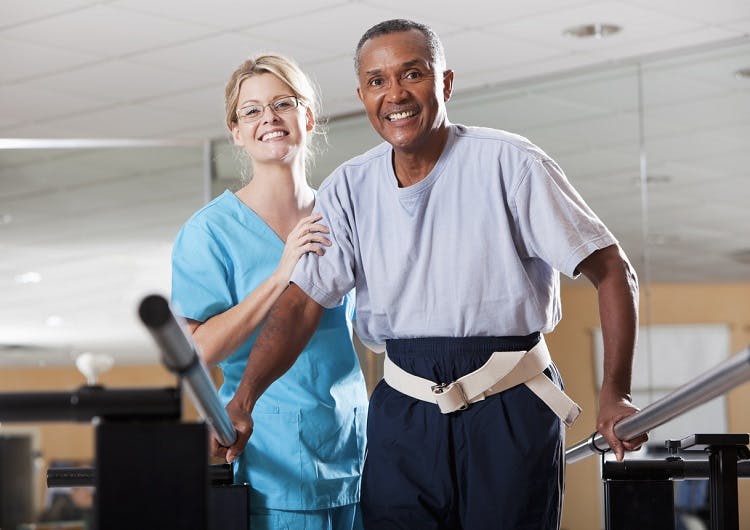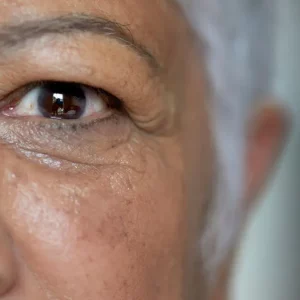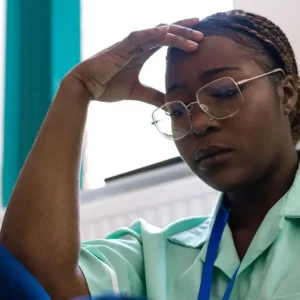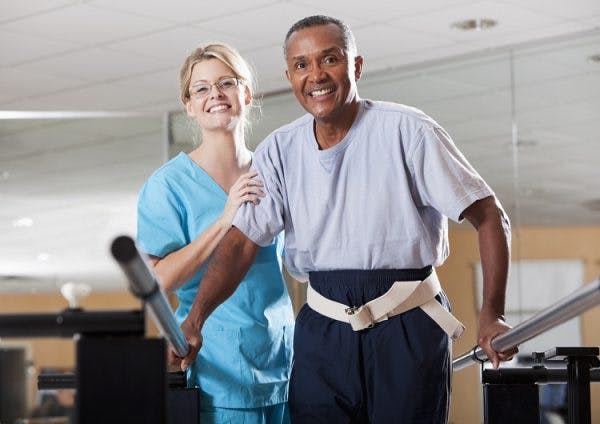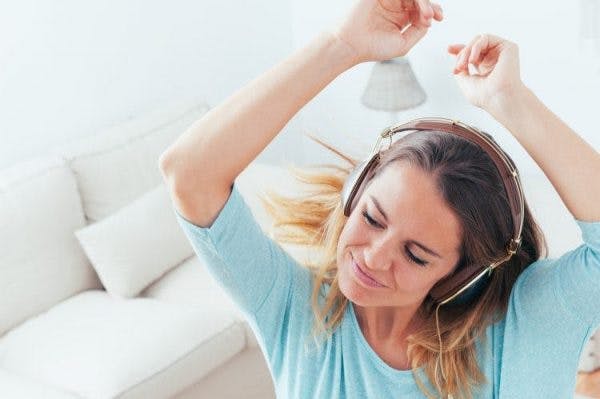After a stroke, survivors may start to actively lean towards the affected side of their body. This is a condition known as pusher syndrome, formally referred to as contraversive lateropulsion. Oftentimes, individuals with pusher syndrome are unaware that they are pushing their body toward one side. Rather, they feel as if they are sitting or standing upright.
As a result, pusher syndrome can significantly affect an individual’s balance and increase the risk of falling. Fortunately, there is a positive recovery outlook for stroke survivors who experience pusher syndrome.
This article will further describe pusher syndrome and outline potential treatments. Use the links below to jump directly to any section.
Causes of Pusher Syndrome
First defined by Patricia Davis in 1985, pusher syndrome refers to the “behavior of pushing the body toward the paretic [affected] side in stroke patients.” Pusher syndrome is sometimes called pusher behavior, although lateropulsion is currently the preferred term used among researchers for the condition. These terms will be used interchangeably throughout this article.
A stroke occurs when the supply of blood in the brain has been compromised. The brain consists of two sides, called hemispheres. The right hemisphere controls movement on the left side of the body, while the left hemisphere controls movement on the right. The majority of strokes are unilateral, meaning that only one hemisphere of the brain is affected.
Survivors who have had a unilateral stroke often experience one-sided weakness (hemiparesis) or paralysis (hemiplegia) on the side of the body opposite of where the stroke occurred. For example, individuals with a right hemisphere stroke often experience motor deficits on the left side of the body.
Depending on the specific area of the brain that was affected, some individuals with hemiparesis or hemiplegia may develop pusher behavior, and begin actively leaning toward the affected side of the body involuntarily. Although more common following right hemisphere strokes or brain injuries with large areas of damage, pusher syndrome can occur following damage to the left or right side of the brain.
While lateropulsion is most commonly associated with unilateral damage to the posterolateral thalamus, it has also been connected with damage to other areas of the brain. This may include areas such as the posterior insular cortex, superior temporal gyrus, postcentral gyrus, and inferior parietal lobe. These regions of the brain are suggested to play major roles in integrating sensory input and regulating upright body posture.
Signs and Symptoms of Pusher Syndrome
Lateropulsion has been estimated to affect 9-63% of stroke survivors. Individuals with pusher syndrome use their unaffected limbs to tilt their body about 18 degrees towards their weaker side. However, because individuals with pusher syndrome may have an altered perception of upright posture, they are often unaware that they are not vertically centered. Rather, they are orienting themselves to align with an incorrect vertical reference.
Along with differences in the perception of vertical posturing, impairments in the vestibular system as well as impaired gravity perception are also common among those with pusher syndrome. While some individuals with lateropulsion may be able to align themselves vertically using visuals, others are unable to do so.
Furthermore, those who are able to vertically align themselves using visual cues from their surroundings often still feel unbalanced when positioned in an upright posture. These challenges may result in unstable positioning while seated, standing, or moving around, increasing the risk of falls.
Pusher syndrome frequently occurs alongside other secondary effects of stroke, such as hemineglect and aphasia, although these conditions do not cause pusher behavior. Hemineglect is an attention disorder that makes it difficult for individuals to notice or respond to stimuli on one side of their body. Individuals with left neglect resulting from a right hemisphere stroke are especially prone to lateropulsion.
Conversely, individuals who experience pusher syndrome following a left hemisphere stroke are more likely to have aphasia. Survivors with aphasia have difficulties producing and/or comprehending language.
While it can be frustrating or worrisome to have pusher syndrome after stroke, most individuals recover their balance and regain the ability to orient themselves in an upright position. Rehabilitation can help address lateropulsion as well as related secondary effects of stroke.
Pusher Syndrome Prognosis
Fortunately, most stroke survivors recover from pusher syndrome, with symptoms usually resolving by 6 months post-stroke. Participation in physical and/or occupational therapy can encourage recovery, allowing individuals to recover from pusher syndrome more quickly. However, individuals with lateropulsion generally stay in a rehabilitation facility for 3 to 4 weeks longer than those without the condition in order to make similar functional gains before returning home.
Although some studies report pusher syndrome does not affect long-term functional outcomes of stroke, other research has found that those with pusher behavior experience lesser functional gains and reduced likelihood of returning home after stroke compared with other survivors. Most studies do agree that pusher syndrome is linked to longer hospital and/or rehabilitation stays and delayed functional improvements.
In order to promote an optimal stroke recovery, it is essential for individuals with pusher syndrome to engage in rehabilitation. Pursuing therapy can activate neuroplasticity, the process through which the brain makes adaptive changes by reorganizing its neural circuitry.
Because of neuroplasticity, functions affected by brain damage have the potential to be rewired to unaffected regions and relearned by through highly repetitive tasks and exercises. Practicing exercises targeted at regaining the ability to orient the body in an upright position can improve symptoms of lateropulsion, promoting recovery. To optimize recovery outcomes, it’s essential for individuals to participate in rehabilitative therapies as soon as possible and develop their functional independence.
Pusher Syndrome Treatment
Treatment for pusher syndrome generally involves working with rehabilitation specialists such as physical and occupational therapists. These professionals will help evaluate the severity of symptoms and suggests effective ways to help survivors maintain a stable upright position when seated, standing and moving around.
Physical therapy for lateropulsion may focus on improving posture and balance skills through targeted exercises. On the other hand, occupational therapy can help individuals with pusher syndrome find safe and effective ways to perform everyday activities, with an emphasis on fall prevention.
Both physical and occupational therapists may use a number of techniques to address pusher behavior, including:
Visual Techniques
Oftentimes, individuals with pusher syndrome are still able to adjust their body positioning so that it aligns with visual cues from their surroundings. For example, survivors may be able to align themselves with a doorframe or a straight, vertical line taped on a wall.
Similarly, practicing sitting or standing upright in front of a mirror with a vertical line taped on it can allow individuals to receive immediate visual feedback regarding their positioning. This can allow them to self-correct until they achieve an upright posture.
Weight-Shifting Techniques
Practicing weight-shifting techniques by leaning from one side to the other can help survivors improve their sense of balance and equilibrium. For example, survivors may practice reaching across their body to retrieve items or overcorrecting their posture by leaning toward the unaffected side of the body. They may also be encouraged to test their stability through extreme weight shifts in a safe environment to further understand their sense of balance.
Positioning Techniques
Therapists may also employ specific positioning techniques to limit the opportunity for survivors to physically push the body toward the affected side. This may include removing wheelchair armrests on the unaffected side or positioning the unaffected hand in the lap with the palm upward to prevent the individual from pushing against it.
Strategies for Correcting Posture
When practicing exercises or activities, therapists will often provide prompts either verbally or tactilely (through touch). While hands-on guidance through therapeutic tasks can be beneficial, attempting to physically move individuals into an upright position is usually ineffective.
This is because attempting to physically correct alignment may cause the survivor to push toward the affected side even more forcefully. Rather, it is recommended to encourage survivors to actively correct their posture, instead of passively being placed into an upright position.
While visual techniques alone may be effective for some individuals, most survivors benefit from using a combination of approaches. Consistently practicing exercises and activities focused on improving upright posture can help stimulate the brain and promote neuroplasticity. As adaptive rewiring occurs, individuals should become accustomed to sitting or standing upright and regain their sense of balance.
Understanding Pusher Syndrome
Pusher syndrome most commonly occurs following a stroke in the posterolateral thalamus. Individuals with pusher syndrome involuntarily lean towards their affected side, causing difficulties with balance and increasing the risk of falls. Some survivors are unaware of their condition, making it more challenging to correct.
Fortunately, most individuals recover from pusher syndrome within 6 months and continue with their stroke rehabilitation journeys. Physical and occupational therapy may focus on improving upright positioning through visual feedback, weight-shifting, and verbal and tactile cuing. Although individuals with lateropulsion often require a few extra weeks of rehabilitation, they usually experience positive recovery outcomes.

